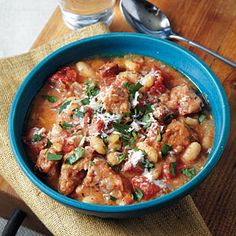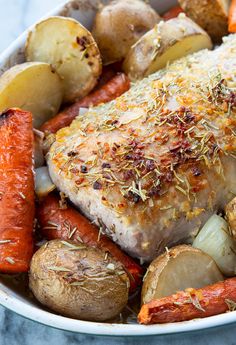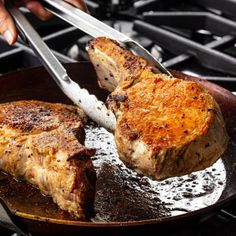Without a Thermometer, What Is the Best Way to Verify if Pork Loin Is Cooked?

The best cut of pork is usually the loin, especially if you’re cooking for a large group. A thermometer is the most convenient way to keep track of cooking temperatures. However, suppose you don’t have a thermometer. In that case, there are alternative ways to detect if the pork is cooked thoroughly enough to eat comfortably.
It all comes down to this: how would you know when the meat is done cooking? Especially if the pork loin isn’t cooked with a thermometer?
Pork loin can be served in a variety of ways, and it can also be used to make British-style bacon.
Let me start by explaining what a pork loin is. Pork loin is pig flesh that is cut along the dorsal side of the rib cage. Many people consider it to be the Rolls Royce of all cuts. A pork Loin can be cooked in a variety of ways, but it’s best known for being used to make British-style bacon. You’ll need good meat from the store to cook a tasty supper. It is possible to check if your pork loin is done without using a thermometer.
It will not be difficult for you to find tender meat in your local butcher store. All you have to do is do some research in your region to find the most excellent meat shop. You could find folks with the correct answers behind the meat counters if you asked the appropriate questions.
Let’s speak about Pork Loin and how to tell if it’s done or not without using a thermometer. I may also suggest various thermometers that you could purchase if you desire.
Select the Finest Pork Loin
Firstly, the most straightforward method for locating the greatest pork loin for cooking is to inquire about it.
When looking for the most incredible beef in town, it’s always a good idea to conduct some research first.
Have a quick chat with one of the staff members at the meat counter and obtain a few pointers.
Keep in mind that cooking pork thoroughly is essential to avoid being ill. To be fit for consumption, all types of pork must be cooked to a minimum of 63°C (or 145°F).
How do you cook pork loin?

After you’ve gotten your perfect piece of pork, set it aside to rest at room temperature. It is crucial if you want your pork to cook evenly. It will keep your meat from becoming overcooked on the outside while still being raw in the center. Allow the meat to remain slightly pink on the interior so that you may appreciate the juicy, delicate meat. The meat will be both gorgeous and delicious. In a short time, the scent will entice you towards it. The pork will be a hit with you.
Second, and most importantly, score the pork loin by using a sharp knife to slice it up while avoiding the skin side. However, if you don’t have a sharp knife, this could be a significant issue; in either case, you can sharpen your dull knife or purchase a new one. You must ensure that the meat is sliced in a single motion. You can’t just keep rubbing your knife across the lovely meat. It will be difficult for you, and the taste of the meat will inevitably change. Get the pork loin and cut it open by cutting deep into it. Slice the pork later.
Take a pinch of salt from the kitchen and rub it into the pork loin’s skin. If you don’t rush it and season it gently, you’ll end up with a platter of deep brown, crisp crackling meat.
However, you must understand when the meat has been cooked, whether it has been grilled, fried, or baked. You must ensure that it is neither overcooked nor uncooked in the middle. In short, you’ll have to put in some effort to meet your taste standards.
What type of thermometer should I get?
You can get massive thermometers on the market. It’s tough to pick the best until you’ve used it yourself. However, allow me to assist you in selecting appropriate thermometers. Thermometers are helpful, but they aren’t ideal for meat. It aids you in checking the temperature in minutes; however, there are some downsides. In many circumstances, a thermometer is not readily available in the home or inoperable.
Second, if you know that piercing a thermometer into your meat will pour out some juices, affecting the flavor of your dish, you will be disappointed. Many people, however, still rely on thermometers.
If you can’t live without thermometers, here are a few I recommend.
Thermometer: Palermo DTH-81 Digital Electronic BBQ Thermometer: Palermo DTH-81 Digital Electronic BBQ Thermometer: Paler This thermometer has a very slim pin that can pierce through your meat without spilling much juice and is still on the market. It’s practical to have because it comes with a collapsible probe and a solid battery backup.
The second alternative, the Etekcity Lasergrip 800 Non-Contact Digital Laser Infrared Thermometer, will make you fall in love. You’ll want something that won’t touch your meat but can tell you the temperature. An infrared digital thermometer gives you the temperature without piercing the meat’s surface. Let us go back to basics and seek ways to check the temperature without relying on a thermometer.
Thermal cameras. Guide’s Rob Carson claims you can get all three temperatures: ambient temperature, surface temperature, and dew point temperature in one shot with these infrared non-contact thermometers. It also has a pleasant, ergonomic grip that may be used to measure culinary or auto maintenance settings.
How to Check whether the Pork Loin is Cooked (Without the Need for a Thermometer)
You may verify how hot the loin is by using a knife or a fork to get to the middle of it and pulling it out. Put a slice of meat on the back of your hand to achieve this. It should be done with considerable caution. You can also feel the soft tissue under your hand and compare its firmness to that of the meat. To test the firmness of the cooked loin, pierce it with your finger.
Raw meat: Raw meat can feel like a fleshy area around your thumb and the base of your palm when it’s raw.
Press your index finger to the tip of your thumb. Rare meat has the same firmness as the area beneath the thumb when the hand is in this posture.
Connect the thumb and middle finger for a medium-rare effect. Remember the fleshy area now. Medium-rare meat has the same firmness as the fleshy portion when the hand is in this position.
Medium: When you press the tip of your ring finger against the tip of your thumb, it feels like skin.
Well done: If the meat is well-done, it should be as hard as the area beneath your thumb when you connect the point of your pinky to the tip of your thumb.
I recommend grilling pork loin for approximately 20 to 25 minutes per pound. However, I recommend that you have a brief conversation with the gentleman behind the desk when you are purchasing the meat. He’ll be able to give you some pointers.
To be sure, most people will pause and cook for a few minutes longer than they believe necessary. Furthermore, being cautious and eating a little overcooked meat is preferable to becoming ill due to eating undercooked pigs.
Pork Chops: Cooking Techniques

- Brining pork chops is one of the simplest ways to keep your grilled pork chops savory. It isn’t entirely required.
- Even if you don’t have it, you can create delicious pork chops using this method.
- I propose that you attempt this strategy if you have some extra time.
- Bringing the pork to room temperature changes the composition of the cells inside the meat, making for a much more flavorful chop. It won’t be salty, but it will be flavorful.
- It’s time to brine the pork chops once you’ve brought them home.
- To 4 cups of water, add four teaspoons (or 1/4 cup) of salt.
- Other seasonings, like garlic, peppercorns, fresh herbs, and lemon, can be added to the brine for added flavor.
- Place the pork chops (or similar thin cut) in a shallow bowl and pour the brine over the top.
- Allow between 12 and 2 hours for this to sit before cooking.
- It’s worth noting that a brief 30-minute brine or a maximum of four hours (whatever you like) can make a big difference.
The Benefits of Purchasing a Meat Thermometer
- If you don’t already own a meat thermometer, I recommend investing in one and keeping it in your kitchen. If you want your pork to be juicy and delicious every time, the best method to do so is to use a meat thermometer. A thermometer guarantees that the meat is adequately cooked and safe to eat.
- The following are some of the advantages of utilizing a meat thermometer during cooking:
- Meat thermometers are inexpensive, with a good one costing roughly $10 to $15.
- One of the most significant advantages of using a meat thermometer is that it improves your health. Undone meat can cause a variety of health problems, including food poisoning. To cook thoroughly, the meat requires a specific temperature.
- You can easily see the values when cooking your meat to ensure proper cooking.
- Because you won’t have any problems cooking the meat with a meat thermometer, it helps you become a better chef.
- It’s easy to use a meat thermometer.
- It allows you to cook more quickly. It is simple to finish your cooking sooner because you can continuously measure temperature during the cooking process.
- Thermometers are a dependable tool to ensure that the meat’s interior temperature has reached the point where it is safe to consume and prepare. It should be consistent to the degree that you and your dinner companions prefer.
How can I tell if the Pork Loin is done without a thermometer?
Pig is cooked at 72 degrees Celsius, or 160 degrees Fahrenheit, if you’re a typical pork chef. This temperature is comparable to a cup of hot coffee. You can always use a fork or a knife to reach the center of the pig loin, and you can feel how hot it is as you pull it out. You can also feel the meat and compare it to the firmness of the soft tissue beneath your thumb to see if it’s cooked. Make a mental note of the stiffness of the cooked meat by poking it with your finger.
The fleshy area between your thumb and the base of your palm will feel raw if the meat is raw.
When you touch your index finger to your thumb, rare meat has some stiffness, precisely like the area below your relaxed thumb.
Touch the tip of your middle finger and your thumb to the meaty part on the medium-rare meat to check for doneness.
Now press the ring finger and the thumb together; the skin beneath your thumb is the medium when you press both fingers together. When you press the tip of your pinkie to the tip of your thumb, it should feel as solid as the area beneath your thumb.
It will take some time, but you can determine the firmness of the pork by using your hand and fingers. However, it is preferable to strike up a conversation with the man behind the meat counter. He will undoubtedly advise you on the type of meat to use, as well as the temperature and time at which the meat should be prepared. This is all you need for a properly cooked and tender piece of meat.
To summarize, cooking pork to perfection is no easy task, as with any dish. Hopefully, you’ve discovered that a meat thermometer can help you complete your assignment. If you don’t have a thermometer, follow the instructions in our post, and you’ll get there.











